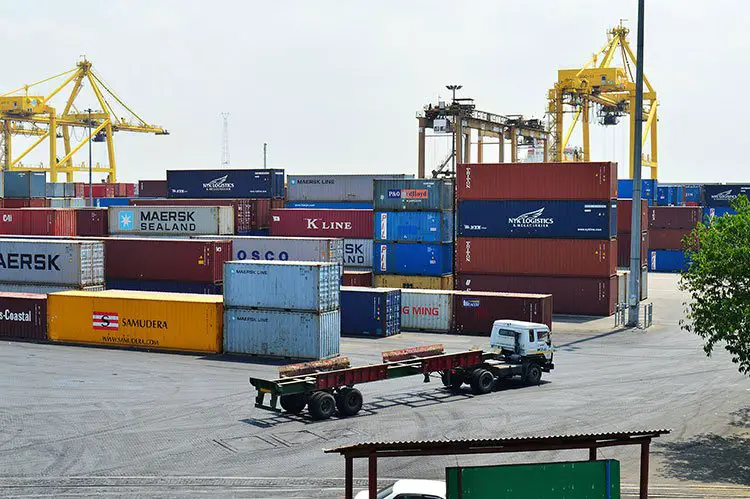What Is An Intermodal Container?

Intermodal Container
Intermodal containers (also shipping containers or ISO containers) are huge standardized shipping containers that are specifically designed for intermodal freight transport. These containers can be used in many different modes of transport like ships, rails, or trucks without needing to load or unload the goods that they are carrying.
Cargo transport operations are benefited greatly because of these containers as they provide speedy shipping at a lesser cost. Internodal transport is less time-consuming there is no need for reloading or repacking.
What is Intermodal Freight Transport?
Intermodal is an innovative transportation method that transports intermodal containers with freight on different modes of transportation without the need to unload or reload the actual cargo inside. This system is very convenient and cost-effective. Intermodal or ISO containers are credited with revolutionizing the global cargo transport system.

Intermodal Container Specifications
The International Maritime Organisation has issued a set of rules and guidelines for using these containers. These containers need to have specific dimensions. This ensures that the internodal containers can be used easily on rail, sea, or land.
Though there are many types and standardized sizes, the most common are the general-purpose containers which are also called dry freight containers. A general-purpose container can have a breadth of 8 feet and a length of 20 or 40 feet. They can also have a breadth of 9 feet, a height of 10 feet, and a length up to a maximum of 53 feet.
Common sizes
- 20 ft * 8 ft * 8ft6″
- 40 ft * 8 ft * 8ft6″
- 20ft x 8ft x 9ft6” (Also called High Cube or Hi-Cube (HC) containers)
Definition of TEU
The unit, TEU or Twenty-foot Equivalent Units, which is used to measure the capacity of container ships comes from intermodal containers.
1 TEU is the amount of cargo that can be held by a container what’s the length of 20 feet and breadth of 8 feet
Types of Intermodal Containers
There are several different types of intermodal containers depending upon the type of cargo they are carrying. These include the following.
1) Dry Freight
As mentioned earlier, these are general-purpose containers used to transport dry cargo and are the most commonly used intermodal containers. They are made up of steel and have strong rigid walls, floors, and roofs. They don’t have any ventilation and refrigeration.
2) Special Dry Cargo
These containers are used a dry cargo that cannot fit into normal containers. These include open-top, ventilated containers, or flat-racked containers.
a) Open Top
These containers of similar to the ones used for dry cargo except that they do not have a roof. They have an open-top that is covered with a canvas usually for the purpose of protecting the cargo.
b) Flat Racked
These containers do not have fixed walls. They just have a floor and two walls. They are used to transport goods such as wood, or other difficult objects.
c) Close Ventilated
These containers are used for cargo that is sensitive to conditions like excessive humidity. They are used to protect perishable items.
3) Thermal Container
These are insulated in the interior especially for the transport of perishable goods.
4) Refrigerated containers

Refrigerated containers or reefers are used to ship perishable items which need to be kept chilled. They have dry ice or liquefied gas to refrigerate the cargo. Generally, food items like fish, meat, and medicines are transported in reefers.
5) Insulated containers
Insulated containers are again the ones that do not require any external temperature regulation. They are insulated from the inside to keep the interior dry and warm.
6) Tanks
There also are tanks that are used for the transport of liquid or gaseous commodities like chemicals or petroleum.
Advantages of Intermodal Containers
1) They need not be loaded and unloaded every time they need to be shifted to a new mode of transport. This saves a lot of time and manpower. All the cargo needs to be loaded once inside the container at the beginning.
2) Also, containers can be loaded and unloaded using cranes and automated systems which makes the process much quicker and cost-effective.
3) The containers can be shipped over long distances very easily while saving a lot of time.
4) The containers are not opened on the way and hence, the risk of tampering or theft is also reduced.
5) These containers are made up of steel or aluminum which helps to protect the cargo from damage or other environmental factors.
6) These containers also easy to manage as they are tracked using unique color codes. This makes this system very reliable and safe.
7) Intermodal containers are very easy to transport. There is are no roadblocks while shifting from one mode of transport to another (for eg. sea to road).
Disadvantages of Intermodal Containers
1) One of the disadvantages of using these containers is that they may not be under-utilized. They have a great capacity which may not get filled completely. An empty container and a fully loaded container will both take the same cost to transport. Hence, it should be ensured that the containers are always full.
2) The cost of transporting these containers may not be that high but the cost of storing them is.
3) They also need to be protected as they can be salvaged for steel or be reused if they are not empty.






